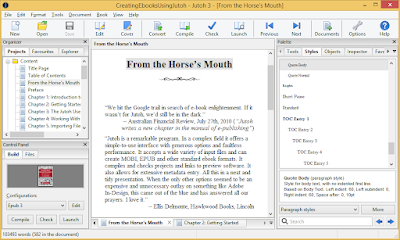"There's no need to stop a story to characterize," writes Editor Sol Stein in Stein on Writing, 1995. You
know your characters inside and out. Their hair color, skin tone,
clothes sense, shoe size and favorite foods. You know how they move and
how they speak. You know everything there is to know about your
characters. Now, the trick is to show the reader everything he needs to
know without describing your hero's traits in a grocery list.
When
it comes to characterization, use every thread on the loom, except
straight narrative description. Don't describe your characters - show
them. Challenge your readers to pick up the clues to characters you
stealthily weave into your story. Each clue brings the reader closer to a
full understanding of your characters.
There are several methods of characterization available - actions, appearance, habits, speech patterns, props, even smells.
1. Actions
"Jane
had brown eyes and limp hair that she tucked behind her ears. She wore a
blue housedress. She was very nervous as she sat down in the chair."
From
this paragraph we know a little about Jane, but it's not interesting or
even very enlightening. An easy way to make your character description
paragraphs more interesting is to make them active. Show Jane's
personality and mood through her actions. Describe her physically as a
backdrop to what's happening in the scene. Use drama, not thoughts, to
characterize.
"Jane perched on the edge of the wooden chair, eyes
trained on the floor. She smoothed her faded housedress over her knees
as if drying moist palms. One thumbnail found its way to her mouth, the
nail already chewed to the quick. She lowered her arm, sending furtive
glances to the other occupants of the room."
This example
describes Jane through her actions. We know she's nervous by her moist
palms, chewed thumbnail and furtive glances. She's also probably poor
(faded housedress) and shy or has something to hide (eyes trained on the
floor). Describing your characters through their actions shows rather
than tells.
2. Habits
Another trick is to give your
characters memorable personality traits. Stroking a mustache, chewing on
the arm of a pair of eyeglasses, twirling hair and playing with an
earring all show something about your character.
For example,
your protagonist might jingle his pocket change nervously every time he
speaks to strangers or she might run her tongue over her bottom lip
before she speaks. The reader may not remember the character's name, but
he'll definitely remember the eye twitch or the tapping foot the next
time that character appears. This is especially useful for characters
who may only appear infrequently in your story, but who are important to
the plot.
3. Props and Appearance
Props can tell a lot
about a character. Think of your immediate reaction to characters
wearing a feather boa, sweat pants, a cowboy hat or expensive jewelry.
Your readers will have a different emotional response between a
character with a tattoo and one with a cane. Use that response to create
characters that come alive.
"Ahead, teetering along the dark
sidewalk on stiletto heels, her beehive hair swaying, her small round
hips churning, her arms hugging two grocery bags, was Bernadette Mansaw,
seventeen-year-old legend."
There's no doubt about what kind of person Mary McGarry Morris had in mind when she created Bernadette Mansaw in Songs in Ordinary Time.
4. Speech Patterns
What
your characters say and how they say it are important threads in the
fabric of your character. Run-on sentences, tight wording, polysyllabic
words, colloquialisms, or stuttering and pauses distinguish one
character from another without author intrusion. Mark Twain endowed Tom
Sawyer with speech that would illustrate his education level, his social
class and his sense of mischief.
"Confound it! Sometimes she
sews it with white, and sometimes she sews it with black. I wish to
geeminy she'd stick to one or t'other -- I can't keep the run of 'em.
But I bet you I'll lam Sid for that. I'll learn him!"
5. Sensory Information
Using
sensory information is often the characterization method most
overlooked. The sound of clicking dentures, the smell of aftershave and
the feel of a limp handshake are all effective characterization tools.
"Jenny wandered through the crowd, hiding behind a cloud of perfume."
What
do we know about Jenny? She's shy and forcing herself to mingle. As a
means of disguising her fear, she wears too much perfume.
"The fresh aroma of cut lumber clung to him like sawdust."
Would
we expect to see this character in an expensive French restaurant?
Probably not, and now the author doesn't have to tell that information.
You know your characters. Now, make sure they are as interesting to your readers as they are to you.
Don't
describe your characters. Let them come alive by weaving their
characterization through actions and use physical habits, speech
patterns, props and sensory information to make them memorable. Your
characters will emerge like the pattern in a loom.
Ruth Kohut is a teacher and Vice Principal in Ontario. She has written
two novels as well as several articles which have appeared in Learning
and Leading with Technology, Canadian Writer's Journal, ETFO Voice and a
Writer's Choice Literary Journal.








